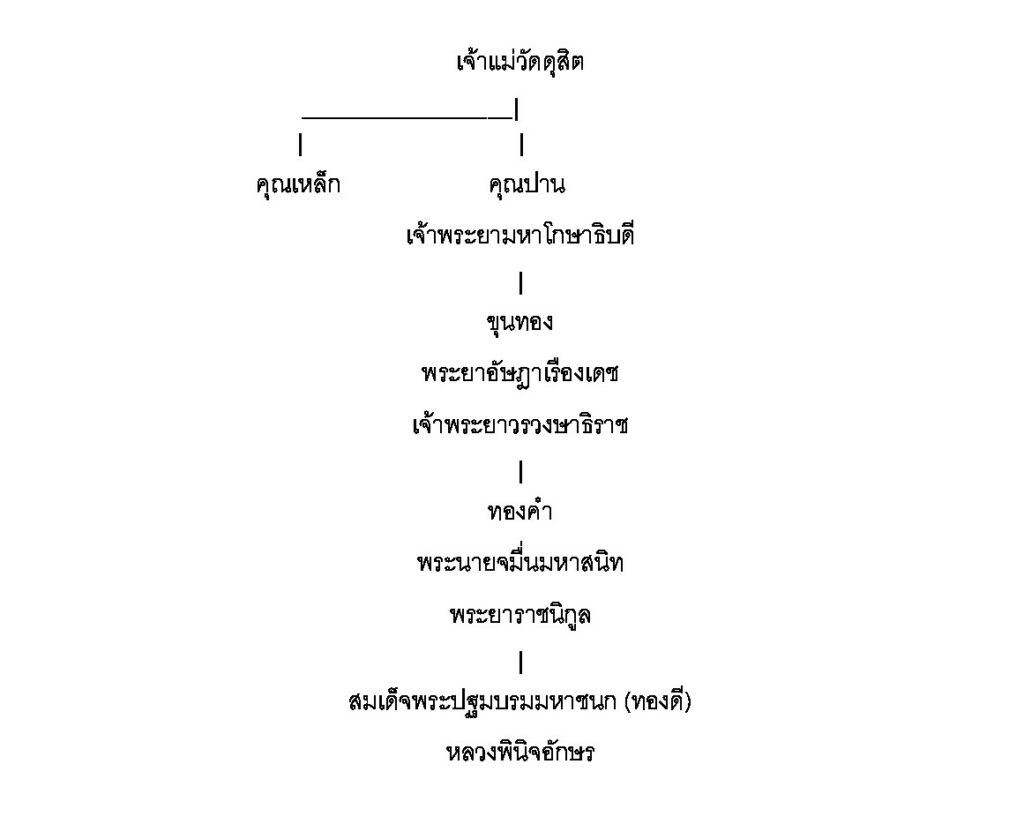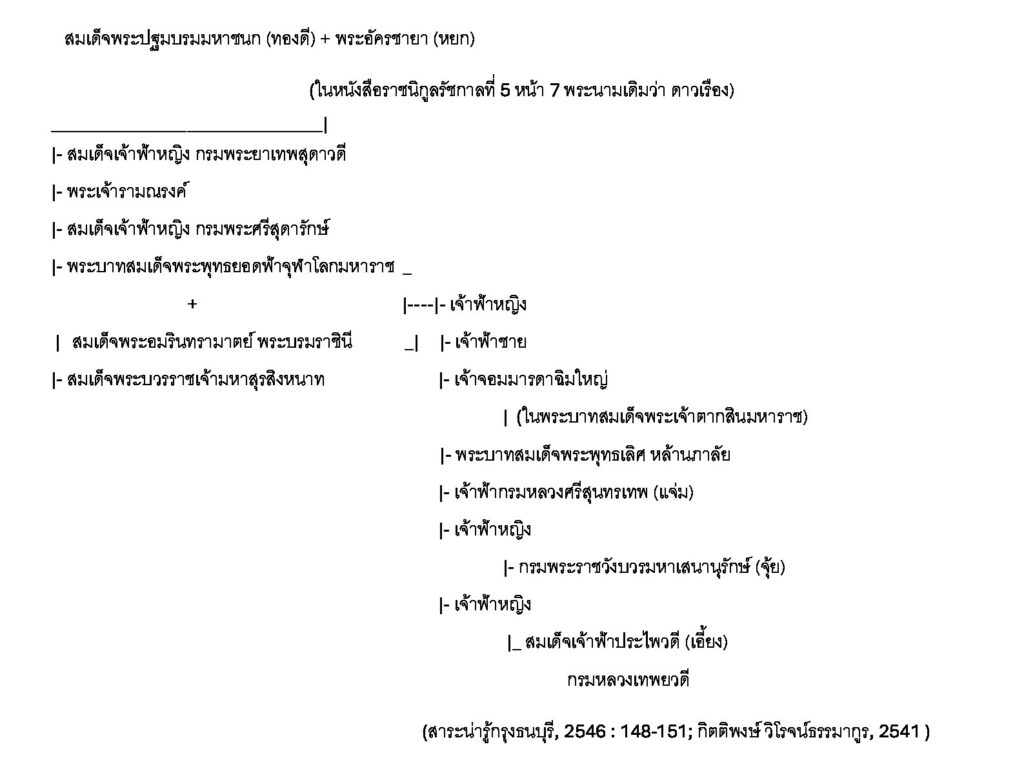King Taksin the Great
Chapter 19: The Top Generals of King Taksin the Great
During the Thonburi period, when Thonburi served as the royal capital, Somdet Phra Chao Taksin the Great was accompanied by numerous valiant and trusted military commanders, namely:
Phraya Surabodin
Phraya Anurak Phuthon
Phraya Kamhaeng Songkhram
Phraya Phichai Dap Hak
Phraya Thainam
Phraya Phiphit Racha
Chao Phraya Chakri (Khaek)
Chao Phraya Phichai Racha (or Phichai Racha)
Chao Phraya Surasi
Somdet Chao Phraya Maha Kasat Suek
19.1 Phra Ya Surabodin
Formerly the governor of Chainat, he was later appointed Phra Ya Kamphaeng Phet by royal favor following the victory over Chaophraya Fang (of Sawangkhaburi). When Azaewunkyi withdrew his army back to Burma via Tak, he was commissioned by the king to lead the royal forces in pursuit of the retreating Burmese army. (Thuan Bunyaniyom, 1970: 98, 150)
19.2 Phra Ya Anurak Phuthon
He was granted the noble title Phra Ya Nakhon Sawan in recognition of his valor in resisting the forces of Chao Phra Fang. Later, during the campaign against Akaewun Ki, he served as a commanding officer at Wat Chan Tai in the outskirts of Phitsanulok. During the battle of Ratchaburi, he was dispatched to aid Phra Ya Thibet Bodi in combatting the Burmese.
He once led the vanguard under the supreme command of Phra Maha Monthian, clashing with the Burmese at Ban Sompoi, where the fighting was fierce and prolonged. On another occasion, Phra Ya Anurak Phuthon pursued the Kalabo army through Phetchaburi. In his final campaign, he was appointed Yokkrabat to wage war against Nakhon Kampuchea.
From these many instances, it is clear that Phra Ya Anurak Phuthon was a seasoned warrior who saw combat throughout the reign of Somdet Phra Chao Taksin Maha Rat. (Source: Thuan Boonyaniyom, 1970: pp. 98, 128, 141, 145, 162)
19.3 Phra Ya Kamhaeng Songkhram
Originally named Khun Chana, he was a local official (kromakan) of Nakhon Ratchasima. Holding a grudge against Chao Phimai, whom he blamed for the death of his former lord, Chao Phraya Nakhon Ratchasima, Khun Chana volunteered to serve Somdet Phra Chao Krung Thonburi by apprehending Chao Phimai. Upon his success, he was elevated to the noble title Phra Ya Kamhaeng Songkhram and was appointed governor of Nakhon Ratchasima.
Phra Ya Kamhaeng Songkhram fought alongside the King in nearly every major campaign. For example, during the Battle of Bang Kaeo, when the Siamese forces surrounded the Burmese at Khao Chachum, Ratchaburi, the King ordered him to advance and lay siege to the Burmese encampment. In the northern campaign during Alaungpaya’s (Alaung Mintayagyi) invasion led by Aka-hson Wungyi (Alaung Su) near Phitsanulok, he was assigned to support Phra Ya Nakhon Sawan from the southern flank. He was also responsible for guarding the supply route to the northern front; however, he was unable to enter Phitsanulok and had to lead the supply train back to the royal encampment.
His loyalty, military acumen, and personal vendetta against enemies of the state made him a key commander in solidifying Thonburi’s rule over the northeastern territories.
When the governor of Nang Rong pledged allegiance to the ruler of Nakorn Champasak, Phra Ya Nakhon Ratchasima dispatched a report to Krung Thonburi, accusing Phra Ya Nang Rong of rebellion. This took place in B.E. 2319 (A.D. 1776). Later, the King summoned Phra Ya Nang Rong to take royal service in the capital. When a military campaign against Kampuchea was launched, the King appointed him as Kiaokkai (เกียกกาย)—a military officer accompanying the royal forces into battle.
(Source: Thuan Boonyaniyom, 1970: pp. 83, 132, 144, 146, 154, 162)
19.4 Phra Ya Phichai Dap Hak — Lord of Phichai, the Broken Sword
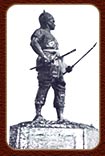
Monument of Phra Ya Phichai Dap Hak
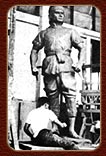
Sanun Silakorn is sculpting the Monument of Phra Ya Phichai Dap Hak
(Photo courtesy of Silpakorn Journal)
Phra Ya Phichai was a chief warrior and a trusted royal guard. His original name was Joy, later known as Thongdee Fun Khao (meaning “White Tooth Thongdee”). He was a farmer’s son from Ban Huay Kha, Mueang Phichai (now a district in Uttaradit Province). He studied boxing under several renowned masters and gained fame as a skilled boxer. He also trained extensively in swordsmanship at Sawankhalok and became very skilled.
When he had the opportunity to visit the city of Tak during the ceremony of holding the Phra Phiphat Satya water rite, which also featured a boxing contest, Thongdee competed against two top-class boxers and won both matches. King Taksin was impressed by his boxing skill and invited him to join his service. Later, he was appointed as Luang Phichai Asa. Besides his boxing and swordsmanship skills, he was also proficient in krabi (sword) and krabong (staff) fighting arts.
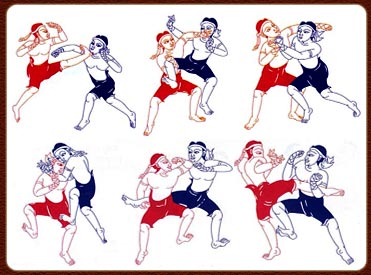
Muay Thai techniques and movements (from Thai Culture Magazine)
Note: “Muay Thai techniques” refers to the various techniques and combinations of punches, kicks, knees, and elbows used in Muay Thai for offense and defense. Mastery of these techniques requires foundational training in each strike individually before learning to blend punches, kicks, knees, elbows, and evasive maneuvers.
Teachers adapt and modify these movements, naming each technique to make them easy to remember. As the number of techniques grew, they were categorized or given rhythmic names to help students memorize them.
Historically, Muay Thai fighters fought bare-handed or with cloth wrapped around their hands, allowing them to grab, throw, break, or twist opponents. This encouraged strategic fighting over brute force, resulting in many techniques.
Later, fighters were required to wear gloves in competitions, similar to Western boxing, and rules were established to protect fighters and facilitate judging. Some traditional techniques became illegal or unusable in modern competition due to protective gear, causing some techniques to be forgotten.
The Royal Chronicles mention that before the fall of Ayutthaya, when King Taksin escaped the Burmese siege, Luang Phichai Asa (a notable fighter) fought fiercely alongside him, breaking through the Burmese forces.
(Source: http://www.msu.ac.th/satit/stu_project/pj102-2-2546/thaiBoxing/, dated 24/8/2547)
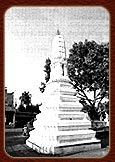
The small chedi at Wat Rajakrueh, believed to enshrine the ashes of Phaya Phichai
(Photo from Silpa Wattanatham Journal)
After gathering forces and preparing the army in Chanthaburi until the time was right to pursue the Burmese troops, King Taksin led the naval forces to capture Thonburi. He then appointed Luang Phichai Asa as the vanguard to successfully attack the camp at Pho Sam Ton. After King Taksin was crowned, he graciously appointed Luang Phichai Asa to the rank of Chaomuen Waiworanat, an elite royal guard commander. When he defeated the lord of Phimai, he was further promoted to Phraya Siharatdechochai. Later, in 1770 B.E. (A.D. 1727), after subduing the northern cities, he was assigned to govern Phichai, holding the title Phraya Phichai, commonly called Phaya Phichai Asa.
Throughout the wars to suppress various rebellions and unify the kingdom, Phraya Phichai Asa was loyal and courageous, leading from the front with his sword and fighting with all his might. While governing Phichai, Posupala led an army to attack the city. At that time, Phraya Phichai fought fiercely with a sword in both hands to defend against the Burmese until one of his swords broke (Professor Rong Sayamanon wrote that both swords were broken—see details in the introduction). His bravery became legendary, and he has been known ever since as Phaya Phichai Dab Hak — “Phichai the Broken Sword.”
In early 2325 B.E., when Phaya Phichai Dab Hak was 41 years old, Somdet Chaophraya Maha Kasat Suek was crowned as King Phra Buddha Yodfa Chulalok, the great monarch of the Chakri Dynasty. Phaya Phichai was summoned to the royal court and asked if he would serve under the new king. With courage, Phaya Phichai replied, “I will not serve two lords; I choose to die following Somdet Phra Chao Taksin.” Therefore, he was ordered to be executed.
This demonstrates Phaya Phichai Dab Hak’s unwavering loyalty and devotion to Somdet Phra Chao Taksin Maharaj. He saw himself as a former vassal of King Taksin and feared that over time he would be distrusted by the new monarch and find no peace. Grieving deeply for King Taksin, he requested to die alongside him.
Phaya Phichai Dab Hak is the progenitor of the families “Wichai Khattaka, Wichai Lakkhana, Srisarakon, Phichaikul, Siripalka, Dithanont,” and others. (Sethuon Suphasophon, 2527 B.E.: 105)
19.5 Phaya Thai Nam (Phra Chiang Ngoen)
Originally the ruler of Chiang Ngoen, a fourth-class city under the authority of Raeng, he pledged allegiance to Phaya Tak and fought alongside him from the time they broke through the Burmese army until reaching Chanthaburi. Phra Chiang Ngoen was not particularly renowned for military prowess and was sometimes considered weak, nearly facing execution. However, he was a servant whom King Taksin showed special mercy toward, and he was one of the city lords whom the King favored bringing to court to instruct in the “methods” of warfare.
Historical records note that during the battle against the rebels at Rayong, Phra Chiang Ngoen took the role of the “rear guard,” hence was called Phra Chiang Ngoen Thai Nam (Phra Chiang Ngoen the Rear Guard) in the Royal Chronicles. After the northern cities were pacified, the King graciously appointed this Rear Guard as governor of Sukhothai. He was a trusted official who earned the King’s high confidence. (Foundation for the Conservation of Historic Sites, 2003: 51-52)
19.6 Phra Phiphit Racha
Key military leader of King Taksin in the first five to six years was Chao Khrua Lian, a Teochew Chinese surnamed Tang Liang (commonly called Tang Liang in Thai). Upon pledging allegiance, he was appointed as Khun Phiphit Wathi. Due to his abilities and extensive influence in the eastern coastal cities, he quickly rose in rank and within less than a year became Phra Phiphit Racha, one of the generals who led the army to attack the Burmese stronghold at Pho Sam Ton camp defending Ayutthaya.
Nithi Eawsriwong believes this Phra Phiphit was the first Royal Treasurer (Kosathibodi) of King Taksin’s reign.
Phra Phiphit, or Phra Kosathipati, was particularly connected to Chanthaburi, a port city that served as the economic base supporting King Taksin’s army in the early period. When King Taksin marched to attack Cambodia and Phutthaimat simultaneously, Phra Phiphit (Tang Liang) commanded a force of 1,481 troops included in the campaign.
Later, after taking Phutthaimat (Hatien), King Taksin appointed Phra Phiphit as Phra Racha Setthi (Royal Wealthy Lord) replacing Mo Thien Sue, who fled to seek help from the Vietnamese king to retaliate against the Thai army. This war prolonged between 1771–1773, until Mo Thien Sue sent envoys to negotiate peace. King Taksin restored Hatien to Mo Thien Sue (the Vietnamese lord) and recalled Phra Racha Setthi (Tang Liang) to Thonburi.
Phra Phiphit or Phra Racha Setthi (the Chinese Tang Liang) led the Teochew Chinese community residing east of the Chao Phraya River near the Grand Palace. Later, during the reign of King Rama I of the Chakri dynasty, upon his coronation, the king allowed Phra Racha Setthi (Tang Liang) to return and govern Phutthaimat as before.
(Source: Pimprapai Pisankul, 1998: 98, 101-102, 155)
19.7 Chao Phraya Chakri the Indian (Mud)
Chao Phraya Chakri Khaek was the father of Phraya Ratchawongsan (Wang) in the Thonburi period. He had a residence beside Wat Hong Rattanaram (in the Thonburi era called Wat Hong Awas Wihan).
Chao Phraya Chakri (Khaek), formerly named Mahamut, descended from Sultan Sulaiman, who ruled the city of Phatthalung since the reign of King Prasat Thong.
Chao Phraya Chakri (Mut) came to serve as a royal page to King Ekatat (Khun Luang Kheeruean—Phra Thinang Suriyasomrin). He held the position of Luang Sak Naiworn, commonly called “Luang Nai Sak.” Before the fall of Ayutthaya, Luang Nai Sak received royal command to collect tax tribute from eastern cities. He collected 300 chang (24,000 baht) from Phraya Chanthaburi. Hearing news of the capital’s fall, he buried the money at Wat Chan. That evening, he disguised himself as a Chinese man, howled as if robbed, and told Phraya Chanthaburi that robbers had stolen all the money. Phraya Chanthaburi disbelieved him and ordered his arrest.
At that moment, Chao Tak’s army reached Chanthaburi. Knowing each other well from serving as royal pages, Luang Nai Sak fled to join him. He brought with him 500 Chinese followers and the 300 chang of tax tribute he had collected, joining Chao Tak to besiege and capture Chanthaburi.
Luang Nai Sak (Mut) was skilled in naval navigation and shipbuilding, and quickly organized the construction of a fleet of 100 warships at Chanthaburi. Chao Tak then led the fleet to Ayutthaya and defeated the Burmese within only seven months after the capital’s fall.
When Chao Tak ascended the throne, he graciously appointed Luang Sak Naiworn (Mut) as Phra Yommarat, future naval commander, and commanded him to lead the fleet to attack Nakhon Si Thammarat. After its successful conquest, he was bestowed the title “Chao Phraya Chakri Sri Ongkharak,” as heir to the Samuhanayok. He became the first Chao Phraya Chakri in the Thonburi kingdom. People commonly called him “Chao Phraya Chakri Khaek” or “Chakri Khaek.”
Chao Phraya Chakri (Khaek) passed away in the Year of the Rabbit, B.E. 2314 (cited from Julada Phakdipoomin, Sakun Thai 48(2480): Tuesday, April 30, 2002, p. 32; and Julada Phakdipoomin, Sakun Thai 50(2565): Tuesday, December 16, 2023).
His body was interred at the Tonson Mosque, Pak Khlong Bangkok Yai. On the day of the funeral ceremony, King Taksin the Great personally presided over the rites himself.
(Prayoonsak Chalayondej, n.d.: 55)
Mud’s lineage has continued through many family lines. All descendants of Sultan Sulaiman’s line are regarded as Sunni Muslim families, although today most bearers of these surnames have largely adopted Buddhism. Those who still adhere to Islam reside in Surat Thani, Phatthalung, and Songkhla provinces. Moreover, numerous branches of these families have further divided, such as Yiadtrong, Huan Mukda, Muda Usen, Kotsawat, Chaiyachana, Plaikaew, Khun Chamroen, Rongdet, Phetkarn, Suchariphun, Suphanchanaburi, Boonyodom, Naowaket, Mitrkool, Boonyapakdi, Sappasamai, Chaowanagawi, Thepsena, Chanaphan, Senathip, Khongsamai, Sewatkul, Polsang, Rangsri, and Phrompalad, among others. Many of these families remain devout Muslims to this day and have dispersed throughout the southern and central regions, as well as Bangkok.
(Prayoonsak Chalayondej, n.d.: 52)
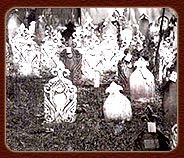
The graveyard of Ton Son Mosque is the burial place of many naval commanders and generals from the era of King Taksin the Great.
(Image from Samphao Siam: The Legend of the Bangkok Chinese)
19.8 Chao Phraya Phichai Racha (formerly known as Luang Phichai Racha)
He was another chief military officer who followed Phraya Wachiraprakarn (Sin) to break through the Burmese encirclement and gather forces in the city of Rayong. He also served as an envoy, delivering letters to persuade Phraya Ratchasetthi at Phutthaisong to join their cause successfully. Later, after Chao Tak had conquered Chanthaburi, Luang Phichai Racha was tasked with overseeing the construction of warships and leading the vanguard to drive out the Burmese from Thonburi to Pho Sam Ton. Luang Phichai Racha remained Chao Tak’s trusted chief military officer throughout.
When King Taksin led the army to attack Nakhon Si Thammarat in B.E. 2312 (1769), Luang Phichai Racha was appointed Phraya Phichai Racha after suppressing the northern cities. In B.E. 2313 (1770), King Taksin placed great trust in him, appointing him as one of the lead generals to advance first. After the campaign, he was promoted to Chao Phraya Phichai Racha and was granted the governorship of Sawankhalok as Chao Phraya Sawankhalok. He was among the former officials who rapidly attained high noble rank.
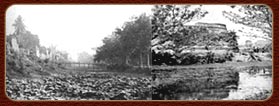
The city walls of Nakhon Chiang Mai and the section known as Chaeng Hua Rin. “Chaeng” refers to the original city wall lines, moats, and the fortifications at the four corners of the city, namely Chaeng Hua Rin, Chaeng Sriphum, Chaeng Kratum, and Chaeng Ku Ruang.
(Image from the book Seen: Architectural Forms of North Siam and Old Siamese Fortifications)
During the campaign to capture Chiang Mai in B.E. 2317 (1774), Chao Phraya Jaomueang Sawankhalok fought to the king’s satisfaction and was granted a short-barreled firearm as a royal gift. However, later during the same campaign, on a Wednesday in the second lunar month, first day of the waxing moon, a plan was made to dig a trench encircling the city. The camp of Chao Phraya Sawankhalok, however, did not fully surround the city. The Burmese ruler of Chiang Mai, Po Suphla, and Po Mayunguan, managed to flee with their families through the Chang Phueak Gate, located on the side of Chao Phraya Sawankhalok’s camp.
The king decreed that Chao Phraya Sawankhalok be judged for negligence in war affairs, for not fully surrounding the city and thereby leaving a route for the Burmese to escape. He was sentenced to fifty lashes and imprisonment. It is understood that he was then transferred to serve in Thonburi from that time onward.
Chao Phraya Phichai Racha never returned to serve in Sawankhalok after this. When anger escalated to the point of execution, while he was in Thonburi, he sent a trusted envoy to request the favor of Chao Chom Prang, sister of the chief consort and daughter of the ruler of Nakhon Si Thammarat. As a consequence, he was beheaded and his head displayed as a warning to others. He passed away around B.E. 2319 (1776).
Chao Phraya Phichai Racha was the progenitor of the Boonlong, Plangkul, and Kriwat families.
(Praphat Trinarong, Thai Journal 20(12), October–December 1999, “The Reign of King Taksin the Great,” 1999: 13-20)
19.9 Chao Phraya Surasi, later Somdet Phra Maha Surasinghanat, was originally named Bunma.

Somdet Phra Baworn Racha Maha Surasinghanat
เมื่อทรงเจริญวัยได้ 16 พรรษา พระราชบิดาได้ทรงนำตัวเข้าถวายเป็นมหาดเล็กในสมเด็จพระเจ้าอยู่หัวสุริยามรินทร์ หรือพระเจ้าเอกทัศน์กษัตริย์องค์สุดท้ายแห่งกรุงศรีอยุธยา ทำงานอยู่ 3 ปี ก็ได้เลื่อนตำแหน่งเป็นนายสุดจินดา มหาดเล็กหุ้มแพร ( “นายสุดจินดา” เป็นบรรดาศักดิ์ (แบบนายวรการบัญชา) ส่วน หุ้มแพร เป็นยศเท่ากับยศร้อยเอกในปัจจุบัน)
When Ayutthaya was besieged by enemy forces in B.E. 2310 (1767), Nai Sutjinda perceived that the city would surely fall to the invaders. Remaining would mean capture or death at the hands of the Burmese, which would serve no purpose. He chose to escape and seek alliance with capable leaders to later reclaim the kingdom. Thus, Nai Sutjinda and three companions devised a plan to flee Ayutthaya, evading the enemy by boat down the Chao Phraya River southward, aiming to join Chao Tak, who had gathered forces to break out of Ayutthaya toward the east. They successfully united at Chanthaburi to aid in organizing the army to liberate Ayutthaya from Burmese control.
Chao Tak was greatly pleased to see Nai Sutjinda, as they had served together and shared close friendship since the flourishing days of Ayutthaya. Chao Tak appointed Nai Sutjinda to the rank of Phra Maha Montri, Chief of the Right Police Department, with a sakdina of 2,000. At that time, Phra Maha Montri (Bunma) was only 24 years old.
Phra Maha Montri (Bunma), later known as Krom Phra Rajawang Bowon Maha Surasinghanat, may be simply described as “born a warrior by blood” or “born with a sword in hand.” Throughout his life, he led troops in battles across all directions, winning almost every engagement. The Burmese rival general (Aza Wungki) nicknamed him “Phraya Suea” (Tiger Lord), a title reflecting his official name upon his investiture as Uparaja, “Maha Surasinghanat.”
It can be said that his greatness lay in his true nature as a warrior. He was born a skilled and brave fighter. During his career, he fought and commanded as a general in a total of 24 campaigns, including…
A. In the reign of King Taksin the Great (B.E. 2310–2325)
Chao Phraya Surasi (Bunma) participated in sixteen military campaigns, namely:
Campaign 1: The assault on the Burmese camp at Pho Sam Ton, B.E. 2310 (1767). After Phraya Tak (Sin) broke through the Burmese encirclement from the east, he established his forces in Chanthaburi. In the 11th month of B.E. 2310, Chao Tak led a fleet of about 100 warships with approximately 5,000 Thai-Chinese soldiers, advancing along the Chao Phraya River to attack and destroy the Burmese forces occupying Thonburi. At that time, Nai Thong-in, who sided with the Burmese, was acting as governor. Chao Tak’s forces then proceeded to attack the camp of the Burmese general Suki at Pho Sam Ton, north of the old capital Ayutthaya. The city and its surroundings were deserted; houses, temples, and monasteries had been burned to the ground. This campaign successfully expelled the Burmese from old Ayutthaya. Phra Maha Montri (Bunma) took part in this assault but had no major responsibilities yet. Nevertheless, he displayed exceptional combat skill, earning recognition among Chao Tak’s forces, and was entrusted with important duties in subsequent campaigns.
After King Taksin established Thonburi as the capital and completed his coronation, Phra Maha Montri (Bunma) brought Luang Yok Krabat of Ratchaburi (formerly named Thong Duang), his elder brother, to serve in Thonburi. King Taksin then elevated Luang Yok Krabat to the rank of Phra Ratchawarin.
Campaign 2: The attack on the Burmese camp at Bang Kung, B.E. 2310. In the late dry season of the same year, Mangyi Manoya, governor of Tavoy, led 3,000 troops to scout Thai territories under orders from King Ava. They encountered a Chinese army garrisoned by King Taksin at Bang Kung, Samut Songkhram. King Taksin appointed Phra Maha Montri (Bunma) as vanguard commander, with the king himself leading the main force. The enemy was decisively defeated.
Campaign 3: The suppression of the rebellious governor of Phitsanulok, B.E. 2311, 11th month. King Taksin advanced a naval force north near Phitsanulok but was wounded by a musket ball fired by the governor’s ambush unit at Kay Chai Tai, Phitsanulok. The army had to withdraw. Although Phra Ratchawarin and Phra Maha Montri’s names are not recorded in this campaign, it is believed they participated, as both brothers were King Taksin’s trusted chief commanders at the time.
Campaign 4: The suppression of Chao Phimai (Krom Muen Theppipit in the reign of King Ekathat). After the rainy season in B.E. 2311 (1768), King Taksin led the army to suppress Chao Phimai at Nakhon Ratchasima. He commanded Phra Ratchawarin and Phra Maha Montri to lead separate forces to attack part of Chao Phimai’s camp at Dan Khun Thot. The battle lasted three days due to the enemy’s strong defense before victory was secured. After this campaign, Phra Ratchawarin was promoted to Phraya Aphaironnarit, and Phra Maha Montri was promoted to Phraya Anuchitratcha, both serving as deputy commanders of the police. At that time, the two brothers remained in Nakhon Ratchasima to govern the city orderly, while the king withdrew his forces back to Thonburi.
Campaign 5: The attack on Cambodia, B.E. 2312 (1769). Upon learning that the Khmer kingdom did not submit to Thonburi as Ayutthaya had, King Taksin ordered Phraya Aphaironnarit and Phraya Anuchitratcha to lead 2,000 troops from Nakhon Ratchasima, and Phraya Kosathibodi to command another 2,000 from Prachinburi to suppress Cambodia during the dry season of B.E. 2312.
Phraya Aphaironnarit and Phraya Anuchitratcha captured Siem Reap, while Phraya Kosathibodi captured Battambang in early rainy season and paused there to await the main army’s arrival. However, during the dry season, King Taksin had yet to advance and rumors spread of his death in Nakhon Si Thammarat. Alarmed, the two commanders feared rebellion in Thonburi and withdrew their troops to Nakhon Ratchasima. Upon returning from the Nakhon Si Thammarat campaign, King Taksin was angered but pardoned them after hearing their explanation.
Campaign 6: The attack on the forces of Chao Phraya Fang, B.E. 2313 (1770). By this time, Phraya Anuchitratcha (Bunma) had been promoted to Phra Yommarat. He was ordered to lead 5,000 troops to attack northern cities, joining King Taksin’s main army and Phraya Phichai Racha’s forces. They captured Sawangkhaburi, held by Chao Phraya Fang, while the main army seized Phitsanulok. This campaign secured northern and central cities under King Taksin’s control. Afterward, Phra Yommarat (Bunma) was promoted to Chao Phraya Surasi Phitsanuwathiraj, governor of Phitsanulok (a rank higher than the chief ministers) at age 28. (Pisarn Senawes, 1972: 321). The vacant Phra Yommarat position was then filled by Phraya Aphaironnarit (Thong Duang).
Campaign 7: The attack on Burmese forces at Sawankhalok, B.E. 2313 (1770). When Po Mayung Wan, the Burmese ruler of Chiang Mai, learned that Thonburi forces had captured Phitsanulok, he feared for Chiang Mai’s safety and led his army to besiege Sawankhalok. Chao Phraya Phichai Racha, governor of Sawankhalok, requested neighboring cities to send reinforcements. Chao Phraya Surasi and Phraya Sukhothai led their troops to assist, and together they defeated the Burmese army.
Campaign 8: The attack on the Burmese at Chiang Mai, B.E. 2313. Upon hearing the siege of Sawankhalok, King Taksin marched his army north in the 4th month of that year. Midway, he learned the Burmese had retreated, but resolved to drive them out of Chiang Mai entirely. In this campaign, Chao Phraya Surasi led an advance force of 15,000 troops. Local rulers along the way, recognizing their compatriots, pledged allegiance, enabling a rapid advance. They defeated the outer Burmese camps and besieged Chiang Mai. The main army joined the siege but failed to capture the city. Concerned about limited manpower and supplies, King Taksin ordered a withdrawal.
Campaign 9: The attack on the Burmese at Phichai, B.E. 2315 (1772). Po Suphla, a Burmese commander reinforcing the forces at Chiang Mai, sought to demonstrate his troops’ prowess by attacking Lublae, then advancing to Phichai. Phraya Phichai defended the city and requested help from Chao Phraya Surasi, then commanding forces in Phitsanulok. Chao Phraya Surasi led troops to assist, attacking the Burmese encircling the city while Phraya Phichai launched a sortie. The Burmese forces were routed.
Campaign 10: The second attack on Chiang Mai, B.E. 2317 (1774). King Taksin led his army to Tak, where he learned that Mon refugees had fled the Burmese through Mae Sot and possibly Phra Chedi Sam Ong passes. He ordered Chao Phraya Chakri (Thong Duang) and Chao Phraya Surasi (Bunma) to lead forces to attack Chiang Mai, while he held at Tak to monitor the refugee movements. As before, local rulers submitted peacefully, and the forces met only minor Burmese resistance south of Chiang Mai. After driving the enemy out, they besieged the city. The main army soon joined, and Chao Phraya Chakri and Chao Phraya Surasi led separate vigorous assaults, resulting in Chiang Mai’s fall. King Taksin ordered the two brothers to govern the Lanna cities from Chiang Mai, while he returned swiftly to Thonburi, fearing Burmese troops pursuing Mon refugees would seize western cities near the capital.
Campaign 11: Battle against the Burmese at Bang Kaeo, Ratchaburi, B.E. 2317 (1774). As anticipated, Nguy Okh Hung led Burmese forces to seize Bang Kaeo north of Ratchaburi, as well as Khao Chongum and Pak Praek in Kanchanaburi province. Initially, King Taksin did not know the full strength of the Burmese troops, intending to capture them alive with a smaller force. He ordered Chao Phraya Chakri to swiftly lead northern troops to besiege the Burmese at Bang Kaeo, while Chao Phraya Surasi was commanded to besiege the enemy at Khao Chongum. Eventually, the Burmese at Bang Kaeo endured severe famine and surrendered. The Burmese forces at Khao Chongum and Pak Praek were defeated by Chao Phraya Surasi’s troops.
Campaign 12: Battle with Aza Wunki at Phitsanulok, B.E. 2317 (1774). Aza Wunki planned to attack Siam from the north in B.E. 2318 (1775) and ordered Po Suphla to attack Chiang Mai and then join him at Phitsanulok. Upon learning this, King Taksin ordered Chao Phraya Surasi to march from Phitsanulok to repel them, while Chao Phraya Chakri advanced with another force. Before engagement, Po Suphla withdrew back to Burma.
Aza Wunki, leading about 20,000 troops, camped at Sukhothai, preparing to attack Phitsanulok. He waited for Chao Phraya Surasi’s forces to enter Phitsanulok, intending to encircle the Siamese armies together. When both Siamese forces had settled in Phitsanulok, King Taksin brought reinforcements from Thonburi. The siege and battles lasted about four months. Food supplies ran out, forcing the two Siamese commanders to break through Burmese lines eastward to Phetchabun. The Burmese then entered Phitsanulok, burned property, seized valuables, and withdrew via Tak and Mae Sot upon hearing of the death of King Mangra of Burma. The Siamese commanders rallied troops and supplies from Nakhon Ratchasima and pursued the retreating Burmese, inflicting heavy losses.
Campaign 13: Defense of Chiang Mai, B.E. 2319 (1776). King Jingguja, Burma’s new monarch, sought to reclaim northern Siamese cities. He sent Kamalo Wun with 6,000 troops to join Po Mayung Wan at Chiang Saen and advance on Chiang Mai. Phraya Wichian Prakan (formerly Phraya Jabaan) was unable to resist and fled to Thonburi. King Taksin ordered Chao Phraya Surasi to join forces with Phraya Kawila, governor of Lampang, to drive the Burmese from Chiang Mai, which they did. Chiang Mai remained abandoned for 15 years before being reestablished in the reign of King Rama I.
Campaign 14: Attack on Champasak City, B.E. 2320 (1777). The chiefs Ok and In of Champasak gathered an army of 10,000 to invade the Isan region of Siam. King Taksin commanded Chao Phraya Surasi to march from Thonburi to join forces with Chao Phraya Chakri at Nakhon Ratchasima. Together, they advanced and captured Champasak early in B.E. 2320, also bringing Attapeu, Surin, Sangkhlaburi, and Khukhan under Thonburi’s control. After this victory, King Taksin elevated Chao Phraya Chakri to Somdet Chao Phraya Maha Kasat Suek, equating him with the Chief of the Royal Forces and appointed him Samuhanayok (Prime Minister).
Campaign 15: Attack on Vientiane, B.E. 2321 (1778). Phra Wo, a former official of Vientiane who had sworn allegiance to Thonburi and settled at Ban Don Mod Daeng on the Mun River after Siam’s conquest of Champasak, was captured and killed by the ruler of Vientiane. In response, King Taksin ordered Somdet Chao Phraya Maha Kasat Suek and Chao Phraya Surasi to lead forces against Vientiane in the first lunar month of B.E. 2321. Somdet Chao Phraya led 20,000 troops by land, while Chao Phraya Surasi gathered 10,000 naval forces from Cambodia to ascend the Mekong River. The ruler of Luang Prabang allied and helped besiege Vientiane for four months, resulting in victory. Several Lao territories, including Tang Kieng of Vietnam, submitted to Thonburi. Somdet Chao Phraya also brought the Emerald Buddha (Phra Phuttha Maha Mani Ratana Patimakorn) and Phra Bang statue from Vientiane to enshrine in Thonburi.
Campaign 16: Suppression of the Rebellion in Cambodia, B.E. 2323 (1780). Civil strife in Cambodia left only a child of four years as heir apparent. Prince Tala Ha (Mu) took power but allied with the Vietnamese to seize the throne. King Taksin appointed Somdet Chao Phraya Maha Kasat Suek as supreme commander, Chao Phraya Surasi as vanguard commander, and Prince Inthraphithak, his eldest son, as deputy commander, commanding a combined force of 20,000 to subdue Cambodia. The order was that once conquered, Prince Inthraphithak should be installed as king. However, before the campaign began, a rebellion broke out in Thonburi. Somdet Chao Phraya and Chao Phraya Surasi returned to quell it. After King Taksin’s reign ended, Somdet Chao Phraya was crowned king by ministers and subjects and moved the capital to Bangkok in B.E. 2325 (1782).
B. The Reign of King Phutthayotfa Chulalok (B.E. 2325–2346 / 1782–1803)
After King Rama I established the Rattanakosin Kingdom, Chao Phraya Surasi Phitsanuwathirat (Boonma) was elevated to Somdet Krom Phra Rajawang Bowon Maha Surasinghanat, the title of the Front Palace (Uparaja or Vice King). He served as the supreme commander of King Phutthayotfa Chulalok Maha Rat, the elder brother of the King. Until his death, he led many military campaigns and held the esteemed position of “Commander of Rattanakosin.” His great military prowess earned the full trust of the King.
Originally, Chao Phraya Surasi’s residence was located at the mouth of Bang Lamphu Canal near Wat Tongpu (Wat Chana Songkhram). His consort, Chao Sri Anocha, lived there, and together they had one daughter. In B.E. 2320 (1777), after Chao Phraya Surasi was appointed as Front Palace, their daughter was named Chao Fa Pikun Thong.
Contemporary records from the Thonburi period, such as the memoirs of Krom Luang Narindthewi, mention that at the end of the Thonburi reign, when Chao Fa Pikun Thong was four years old, a crisis (“Ko-li”) occurred in Thonburi. While the two elder commanders—Somdet Chao Phraya Maha Kasat Suek and Chao Phraya Surasi—were on military campaigns in Vietnam and Cambodia, Phraya San and his men raided the home of Phraya Suriya Aphai, nephew to the two commanders.
The book Thai Battles Against Burma records the role of Chao Sri Anocha (Chao Sirirat) at this time: “When the fighting broke out, Lady Chao Sirirat, consort of Chao Phraya Surasi, was at the house near Bang Lamphu Canal. Upon learning that enemies had raided Phraya Suriya Aphai’s house, she conspired with Phraya Cheng, Phraya Ram, and Mon commanders to suppress the rebellion.” Meanwhile, the Chiang Mai Local Chronicle records that “Chao Sri Anocha sent a letter (dan) to the people of Pak Phreo, ordering them, ‘As long as I live, I will not allow you to take control of the city. You may trade freely, but only as I permit.’ The people of Pak Phreo then arrested and executed Phraya Sing and Phraya San.”
The volunteers from Pak Phreo were likely Lao or Yuan under Chao Sri Anocha’s influence. The letter (dan) was an order to quell the rebels. Pak Phreo later became home to many Yuan-Chiang Saen people after Chao Kawila, brother of Chao Sri Anocha, led a campaign to capture Chiang Saen in B.E. 2347 (1804). This evidence clearly shows Chao Sri Anocha’s influential role behind the establishment of the Chakri Dynasty.
After the coronation and establishment of the Chakri Dynasty in B.E. 2325 (1782), Somdet Chao Phraya Maha Kasat Suek (Thong Duang) ascended the throne as King Phutthayotfa Chulalok, while his younger brother Chao Phraya Surasi (Boonma) was appointed Krom Phra Rajawang Bowon Maha Surasinghanat (1786–1823).
Krom Phra Ratchawang Bowon Maha Surasinghanat (The Front Palace) and His Legacy
Krom Phra Ratchawang Bowon Maha Surasinghanat graciously commissioned the construction of an extensive royal palace complex known as the Bowon Palace on the grounds of Tha Phra Chan (Moon Pier). This complex included three royal mansions serving as residences—Siwamok Phiman, Phiman Dusida—and the Suttasawan Throne Hall, built to house the revered Phra Phuttha Sihing Buddha image, which he had brought from Chiang Mai. The entire Front Palace compound was modeled closely after the Grand Palace (Wang Luang), featuring elephant stables, horse stables, halls for officials, treasuries, and the Front Palace’s own Temple of the Emerald Buddha (Wat Phra Kaew Wang Na).
The key difference was that while the Grand Palace’s inner chambers were constructed from wood, those in the Front Palace were built as multi-story masonry buildings. Notably, the residence of Chao Sirirat (also known as Chao Sri Anocha), the principal consort, was a complex of mansions with two-tiered roofs. The residence of their daughter, Chao Fa Pikun Thong, was similarly grand.
The Front Palace was fortified with ten bastions, including the Bastion of the Moon and the Bastion of the Sun. Outside the southern wall of Bowon Palace stood a temple originally called Wat Salak, renamed by Krom Phra Bowon as Wat Nippanarama. When the Buddhist canon (Tripitaka) was recompiled in B.E. 2331 (1788), this temple was renamed Wat Phra Si Sanphet. In B.E. 2345 (1802), when Burmese forces invaded Chiang Mai, Krom Phra Bowon led the army northward to suppress the invasion.
However, upon reaching the city of Thoen, his gout flared severely. He entrusted command to Krom Phra Ratchawang Lang (the Rear Palace, held by Phraya Suriya Aphai) and returned to Bangkok. He passed away in B.E. 2346 (1803) at the age of 60.
After Krom Phra Bowon Maha Surasinghanat’s death, historical records do not detail much about Chao Sri Anocha, but it is believed she remained at Bowon Palace until her death. Her ashes are enshrined today at Wat Phra That Lampang Luang in Lampang. Their daughter, Chao Fa Pikun Thong, was granted the title Krom Khun Srisunthorn in B.E. 2351 (1808) and passed away in B.E. 2353 (1810) at age 34. She was a direct descendant of Chao Kawila of Chiang Mai.
Chao Sri Anocha, “The Lady of Lanna,” is famed for her role in the “Hngai Mueang” (City Overturning) campaign that enabled the two elder commanders of Thonburi—former nobles of Ayutthaya and later the Grand Palace (Wang Luang) and Front Palace (Wang Na) of Rattanakosin—to consolidate power, crown the new dynasty, and secure the Chakri lineage. The Front Palace and Grand Palace rulers recognized and revered her as a pivotal force behind the strong ties between the Chakri monarchy and the seven ruling families of Lanna.
The site of Bowon Sathan Mongkhon Palace (“Wang Na”), the residence of Krom Phra Bowon Maha Surasinghanat and Chao Sri Anocha, was a politically significant land with a dramatic history spanning over two centuries since the founding of Rattanakosin in B.E. 2325 (1782). Royal protocol dictated “when the elder brother dies, the younger brother inherits,” so the Grand and Front Palaces were built with near parity—each having duplicate sets of royal gifts such as trees of silver and gold. However, the younger brother, the Front Palace lord, was expected to die before the elder, Grand Palace ruler.
During his illness, Krom Phra Bowon ordered to be carried in a palanquin to visit Wat Phra Si Sanphet (later known as Wat Mahathat) to pay respects to the principal Buddha image. There, he clasped the Buddha’s hand and offered his sword in homage, inspiring the design of the Bowon Monument that now stands before Wat Mahathat.
At that time, it was said he lamented,
“I have worked hard with my thoughts and strength… but soon it will belong to another…”
and he cursed,
“…In the future, whoever not of my lineage who comes to possess it, may spirits and deities never grant them peace…”
(from Somdet Krom Phraya Damrong Rajanubhab’s Legend of the Front Palace, cited in Somchot Ongsakul’s Wang Na: 200 Years of History on the Thammasat Grounds, 1982, pp. 4–5).
Notes:
Krom Phra Bowon Maha Surasinghanat suffered severe gout during the campaign to aid Chiang Mai in B.E. 2345 (1802). The condition worsened to the point of requiring immersion in water. He stayed in Thoen for treatment, delegating command to Krom Phra Ratchawang Lang, who later successfully defeated the Burmese siege of Chiang Mai. After the campaign, Krom Phra Bowon recovered somewhat and returned to Bangkok in B.E. 2346, but the disease relapsed and he died at Phra Thinang Burapha Phimuk inside Bowon Palace in the 12th lunar month, the 4th waning day of the Pig year, aged 60 (Bowon Royal Biography, 1972, p. 5).
Krom Phra Bowon Maha Surasinghanat had 18 sons and 25 daughters, totaling 43 children. He had four main lineages continuing his royal bloodline: Asunee na Ayutthaya, Sangkhad na Ayutthaya, Patamsing na Ayutthaya, and Neerasing na Ayutthaya.
The first major political upheaval in this domain occurred during King Rama V’s reign when Krom Phra Bowon Wichai Chan passed away on August 28, B.E. 2428 (1885). King Rama V then abolished the title of “Front Palace” and established the position of “Crown Prince” instead, changing the royal succession tradition from “brother to brother” to “father to son.”
Since then, the story of the “Front Palace” became a relatively hidden legend. Parts of the palace grounds were repurposed for the National Museum and National Theatre. The inner palace buildings, such as the residence of Chao Fa Pikun Thong at Tha Phra Chan, were demolished to make way for Ministry of Defense properties and military barracks, including the Navy, the 11th Royal Guards, and Infantry Battalions 4 and 5 (Somchot Ongsakul, 2002, pp. 3–8).
19.10 Somdet Chaophraya Maha Kasetthik (Thongduang)
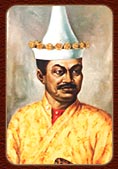
Kosapan (Image from the book ‘The Biography of Kosapan’ and the travelogue of the journey to France)
Khun Kosapan, who once served as the Siamese royal envoy to foster diplomatic relations with King Louis XIV of France, and Khun Kosalek, a distinguished military commander under King Narai the Great, were sons of Chao Mae Wat Dusit, the wet nurse of Prince Narai Ratchakuman. This was due to the early passing of the prince’s biological mother during his childhood. Khun Kosapan is recognized as a progenitor of the Chakri dynasty (Somchai Phumsart, 1995: 1-42).
Khun Kosapan’s eldest son was named Nai Khun Thong, who was later appointed Chaophraya Worawongsathirat and served as Minister of the Treasury. Nai Khun Thong’s eldest son, Nai Thongkham, subsequently became Phaya Rajanikul Palat Thul Chalerm Mahatthai, a senior official in the Ministry of Interior. Nai Thongkham had a son named Nai Thongd, who later held the title Luang Phinit Aksorn.
Luang Phinit Aksorn married Dao Rueang, also known as Yok, and resided within the city walls north of Pom Phet (Diamond Fort). The family bore five children in total.
The first child was a daughter named Sa, who married Saem, the son of the Director of the Police Department, who was later honored with the title Somdet Chaofa Ying Krom Phraya Thepsutthawadi. The second child was Khun Ramnarong, who died before the fall of Ayutthaya to the Burmese. The third was a daughter named Kaeo, who married Chao Khrua Ngoen, a Chinese with the surname Tan; she later became Somdet Chaofa Ying Krom Phraya Srisudarak. Their sons and daughters became the progenitors of the Thephasadin, Montharikul, and Isarangkul noble families of Ayutthaya.
The fourth child was Thongduang, born on Wednesday, March 20, 1736 (Year of the Dragon), during the reign of King Borommakot of Ayutthaya. He later ascended the throne as King Phutthayotfa Chulalok the Great, the founder of the Chakri Dynasty.
The fifth child was Boonma, who later became Krom Phrarajawang Boworn Maha Surasinghanat.
The sixth child was Princess Gu, also known as Chao Khrok Wat Pho, the ancestor of the Narintharakul family of Ayutthaya.
The seventh child was named La, who later became Chao Fah Krom Luang Chakrajetsa, progenitor of the Jesadangkul family of Ayutthaya.
(Reference: Royal family genealogies 1969, “Royal Names of Princes and Princesses in Rattanakosin,” Phrachan Printing House, Bangkok, pp. 1–2)
A remarkable story is told from the childhood of young Thongduang. It is said that when he was five years old, he fell into a fire but miraculously suffered no harm. Later, he studied under several masters and acquired extensive knowledge in various disciplines. At age thirteen, he underwent the traditional topknot shaving ceremony, where Prince Uthumphon, Krom Khun Phropinit, personally cut his topknot. Afterwards, he became a page to the prince, alongside Sin, who would later become King Taksin the Great in 1757.
At age twenty-two, Thongduang respectfully requested to leave court service and ordained as a monk at Wat Mahathalai, while Sin had already been ordained at Wat Kho Sawat for three years.
Three years later, during the reign of King Ekathat (the last king of Ayutthaya), Thongduang married the daughter of a wealthy couple, Thong and Som, named Nak, a beautiful woman from Amphawa District, Ratchaburi Province. Subsequently, Thongduang transferred to serve in Ratchaburi and was appointed as Luang Yok Krabart of Ratchaburi.
During the fall of Ayutthaya to the Burmese, Luang Yok Krabart remained in Ratchaburi. At that time, his wife was heavily pregnant. When his younger brother Boonma invited him to join service with Phraya Tak (later King Taksin), Thongduang had to delay his departure and entrusted Boonma to escort Nang Nok Yiang (mother of Phraya Tak), who was hiding at Ban Laem, along with handing over the ancient golden sword and two rings set with precious stones to Phraya Tak.
In 1768, Luang Yok Krabart began serving in Thonburi, receiving the noble title Phra Racharin (sometimes called Phra Rachawarin), with duties as the Chief of the Right Police Department, residing near Wat Bang Wa Yai (Wat Rakhang). That year, he engaged in his first battle and suppressed Phraya Worawongsathirat at the Khun Thot checkpoint. After quelling the Phimai rebellion, he was promoted to Phaya Apaironarit, deputy commander of the Police Department.
In 1769 (B.E. 2312), he led the campaign to capture the cities of Phra Tabong (Battambang) and Siem Reap. In 1770 (B.E. 2313), he accompanied King Taksin the Great on the campaign to suppress the rebellion of the Lord of Phra Fang at Sawang Kaburi. During this time, at the age of 34, he was promoted to the noble rank of Phra Yommarat.
The following year, in 1772 (B.E. 2315), he was appointed as Chao Phraya Chakri and led the army to conquer parts of Cambodia, capturing the cities of Baphnom, Bantay Phet, and Phothisat.
In 1773 (B.E. 2316), he served as the vanguard commander under King Taksin in campaigns against the cities of Chiang Mai, Lampang, Lamphun, and Nan. That same year, when the Burmese launched an invasion of Ratchaburi, the northern armies successfully repelled them in 1774 (B.E. 2317). When the Burmese later attacked Chiang Mai, King Taksin ordered Chao Phraya Chakri to lead the army to confront them, but the Burmese retreated before the battle.
In 1775 (B.E. 2318), he was appointed as commander-in-chief and led troops to assist in repelling the Burmese attack on Chiang Mai. Upon hearing this, the Burmese retreated. Later, the Burmese commander Aza Wungyi advanced to attack northern cities and camped at Sukhothai. At that time, Chao Phraya Chakri and Chao Phraya Surasi were marching to attack Chiang Saen but, upon learning of the Burmese presence, they redirected their forces to meet them at Phitsanulok.
Before Aza Wungyi could lay siege to Phitsanulok, his forces repeatedly attempted to attack the Thai camp but were repelled each time. Aza Wungyi then praised the Thai commanders and proposed a one-day ceasefire. During this truce, the commanders met on horseback in the battlefield. Upon seeing Chao Phraya Chakri’s appearance and bearing, Aza Wungyi said:
“…This man is handsome and skilled, able to fight even an old man like me. Take care of yourself, for you will one day become king…”
He further warned:
“…Hold your city firmly. We will take Phitsanulok in this campaign…”
(Sources: Pranee Jaemkhuntean, 1991: 24)
However, according to Sang Phatnothai (undated: 86), Aza Wungyi’s intention was to sow discord among the Thais, which is worth consideration.
In 1776 (B.E. 2319), he led the army to conquer the eastern Lao cities of Nakhon Champasak, Sri Tandorn, Attopeu, and various Cambodian forest cities. Following this, he was elevated in rank to Somdet Chao Phraya Maha Kaset Sik, Piluk Mahima Thun Nakhonara A Dech Naresuan Raj Suriyawong, Ongbat Mulikakorn Boworn Rat Pranaiyak — a noble rank with full regalia equivalent to the highest of chiefs.
In 1778 (B.E. 2321), he led the campaign to conquer the cities of Lan Xang and Vientiane, successfully capturing Vientiane as a vassal city and Luang Prabang as a tributary territory. On the return journey, he brought back the revered Emerald Buddha (Phra Phuttha Maha Mani Rattana Patimakorn) and the Phra Bang statue from Vientiane to Thonburi.
In the year 1780 (B.E. 2323), a rebellion erupted in the Kingdom of Cambodia. He was appointed as the supreme commander to quell the uprising. However, before the campaign could be brought to completion, disturbances arose in Thonburi, necessitating his return to the capital in 1782 (B.E. 2325). In that same year, at the age of 47, he was formally crowned king.
Following the grand celebration of the Emerald Buddha Temple in 1809 (B.E. 2352), His Majesty King Phutthayotfa Chulalok fell ill due to the infirmities of old age and passed away at the Phra Thinang Lang Sip Hang (the Hall of Eleven Rooms).

The royal emblem of His Majesty King Phutthayotfa Chulalok the Great is displayed above the archway at the entrance to the central prang of Wat Arun Ratchawararam, as well as on the covers of ancient royal manuscripts in chronological order.
(Image sourced from the book “Royal Emblems”)
The royal emblem is circular in shape, depicting a lotus bud-shaped “Unalom,” which represents the third eye of Lord Shiva, symbolizing great power and spiritual influence. At the center is the character “อุ” (pronounced “U”), representing the name “Duang” (the King’s given name). Surrounding the emblem are lotus petals, symbolizing a just and righteous heart. This banner was once again proudly raised when the Thai people celebrated the 200th anniversary of Bangkok and jointly honored King Phutthayotfa Chulalok the Great with the title “Maharaj” (the Great King).
At that time, the royal flame tree, His Majesty’s favorite, blossomed with bright yellow flowers, blooming abundantly throughout the surrounding area.
Note:
uriy Phumiphom (1996: 160-161) described the tree favored by His Majesty King Rama I, the “King of Trees,” as the Ratchaphruek (Cassia fistula). This tree holds significance in Hindu rituals. Ancient Thai beliefs held that when digging the foundation hole for a house post, the wood of the Ratchaphruek tree should be used. Furthermore, when erecting the house post, five Ratchaphruek leaves, three banana leaves, and one sugarcane leaf were tied together at the tip of the gable post. S. Playnoi (1984, Plants of Auspicious Significance) wrote:
The Ratchaphruek tree is considered auspicious to plant for houses built in the Year of the Rat, as it is believed to improve one’s status and livelihood. The Ratchaphruek symbolizes sovereignty and power, regarded as the “king of trees.” Its flowers are traditionally used in paying respect to teachers in classical royal theatre performances. Ancient wisdom advises that if planting a Ratchaphruek tree near a residence, it should be placed on the west or southwest side to bring great auspiciousness.

(Cassia fistula Linn)
The Ratchaphruek Tree (Cassia fistula Linn)
The Ratchaphruek tree, scientifically named Cassia fistula Linn, belongs to the family Caesalpiniaceae. In Thailand, it is known by various names including Chai Phreuk (ชัยพฤกษ์), Khun, Lom Laeng (Northern Thai/Yuan language), Glak Kluak Kheuy (Pattani), Ku Peya (Karen of Kanchanaburi), Peu Yu, Pu Yo, Peo So, and Mae Lai Yu (Karen of Mae Hong Son).
The Ratchaphruek naturally grows across India and Indonesia and has been introduced to many countries such as Nepal and the Philippines, where it is called differently—e.g., Sonali in Bengal, Sonalu in Nepal. Its common English names include Indian Laburnum, Golden Shower, Purging Cassia, and Pudding Pipe Tree.
The Ratchaphruek is a deciduous tree thriving in dry mixed deciduous forests. When young, its bark is grayish-green, turning reddish-brown as it matures. The compound leaves have 4–6 pairs of leaflets. Bright yellow flowers bloom in clusters during the hot season, making the tree a popular ornamental plant. Its fruit is a long, cylindrical pod. In India, its leaves are used as fodder.
The wood is yellowish-brown with short fibers, which makes planing and finishing difficult. It is hard and durable. The pulp inside the pod is edible and used as a laxative, popular in Arab countries and China. While the pulp is effective for pregnant women, caution is advised as the outer parts of the fruit may cause miscarriage. In fact, the fruit can be used to make 16 types of medicine, the inner pulp 15 types, and the roots are used to treat fever and heart disease. The leaves expel roundworms and are sometimes used as medicine for elephants. The seeds induce vomiting.
In Thailand, the Ratchaphruek wood is commonly used for house posts, bridge pillars, pestles, cart wheels, cart beams, plow handles, lathe tools, and drum sticks for traditional drums such as the Thon and Ramana drums. Some Thai groups chew its tannin-rich sap as a substitute for betel. The wood and bark contain 10–12% pyrogallol tannin, making the bark excellent for tanning leather. In India, the wood is crafted into furniture, carvings, and boards. Thus, the Ratchaphruek is a highly valuable and beneficial tree for those who cultivate it.
The Ancestral Lineage of His Majesty King Phutthayotfa Chulalok the Great
and Krom Phra Ratchawang Bowonmahasurosinghanat
